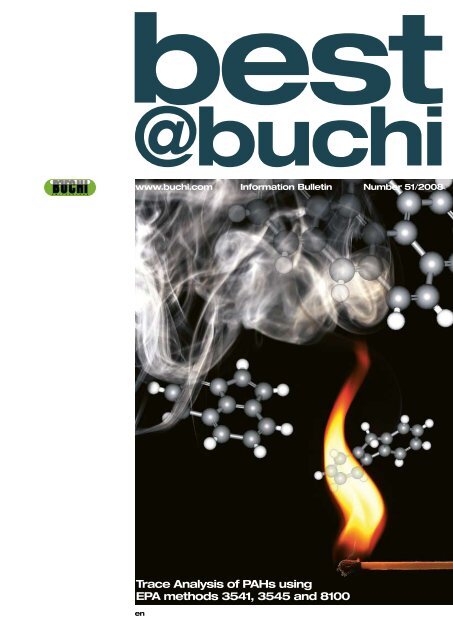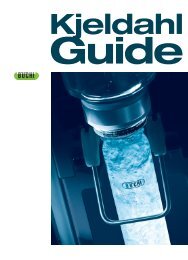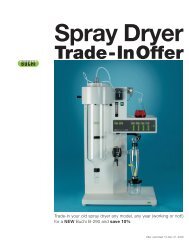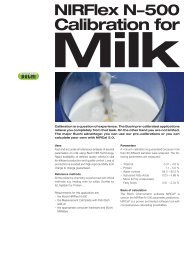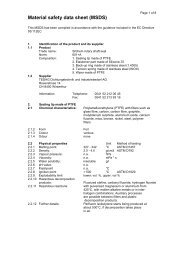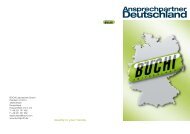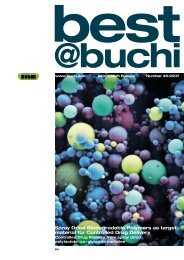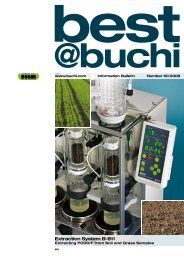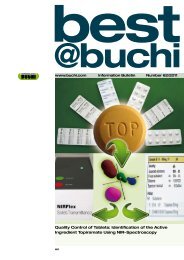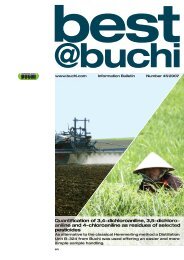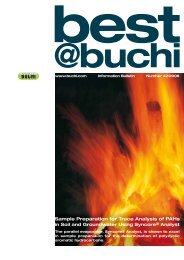Trace Analysis of Pahs using EPA methods 3541 - BÜCHI ...
Trace Analysis of Pahs using EPA methods 3541 - BÜCHI ...
Trace Analysis of Pahs using EPA methods 3541 - BÜCHI ...
Create successful ePaper yourself
Turn your PDF publications into a flip-book with our unique Google optimized e-Paper software.
est<br />
@buchi<br />
www.buchi.com Information Bulletin Number 51�2008<br />
<strong>Trace</strong> <strong>Analysis</strong> <strong>of</strong> PAHs <strong>using</strong><br />
<strong>EPA</strong> <strong>methods</strong> <strong>3541</strong>, 3545 and 8100<br />
en
est@buchi 51/ 2008 en<br />
<strong>Trace</strong> <strong>Analysis</strong> <strong>of</strong> PAHs: Evaluation <strong>of</strong> two Extraction Methods<br />
(<strong>EPA</strong><strong>3541</strong> and <strong>EPA</strong>3545) and Optimization <strong>of</strong> subsequent<br />
Concentration<br />
Authors: J. Cavegn, B. Haag, R. Hartmann,<br />
Buchi Labortechnik AG, 9230<br />
Flawil, Switzerland<br />
The Extraction System B-811 and<br />
the Syncore Analyst parallel concentrator<br />
as well as the Pressurized<br />
Solvent Extractor were evaluated<br />
for the pretreatment <strong>of</strong> samples<br />
containing PAHs. Recoveries <strong>of</strong><br />
extraction and subsequent concentration<br />
<strong>using</strong> acetone + n-hexane<br />
(1+1) were 70-95% for 2 ring and<br />
90-100% for the less volatile 3-5<br />
ring PAHs. A good precision<br />
(95% confidence level) <strong>of</strong> less than<br />
6%, naphtalene excluded (12%), was<br />
found. No significant difference<br />
was observed between the two<br />
extraction <strong>methods</strong>.<br />
Introduction<br />
Polycyclic aromatic hydrocarbons<br />
(PAHs) are organic pollutants primarily<br />
formed by incomplete combustion<br />
and incineration. PAHs adsorb strongly<br />
to small carbonaceous particles but<br />
are also present in the vapor phase.<br />
Therefore, they can undergo long<br />
range transport. Typical concentrations<br />
are in the sub-ppb to ppm range.<br />
PAHs also bioaccumulate in food webs<br />
and are partially mutagenic and carcinogenic.<br />
Therefore, PAH analysis is requested<br />
by regulatory bodies. The US<br />
Environmental Protection Agency<br />
(<strong>EPA</strong>) introduced a priority pollutant<br />
list <strong>of</strong> 16 PAHs (<strong>EPA</strong>610) in 1982. For<br />
solid and hazardous waste testing, the<br />
<strong>EPA</strong> approved method reference is<br />
SW-846.<br />
The analyses <strong>of</strong> PAHs contamination<br />
at the trace level includes sample<br />
extraction and extract concentration.<br />
Both automated Soxhlet extraction<br />
(<strong>EPA</strong><strong>3541</strong>) and pressurized solvent<br />
extraction (<strong>EPA</strong>3545) are approved<br />
extraction techniques (<strong>EPA</strong>3500) for<br />
solid samples. The extract volume<br />
is reduced to 1 ml for maximum<br />
sensitivity (<strong>EPA</strong>8100).<br />
2-3 ring PAHs can be lost by<br />
evaporation and the heavy volatile<br />
PAHs due to adsorption to glass<br />
walls. Therefore, concentration and<br />
extraction procedures as well as<br />
cleaning <strong>of</strong> the glass equipment are<br />
crucial factors to be optimized.<br />
Cross contamination between<br />
samples <strong>of</strong> high and low concentrations<br />
is one <strong>of</strong> the critical points<br />
in trace analysis. This is particularly<br />
valid for simultaneous sample concentration.<br />
Reasons can be sample transfer<br />
by vapor phase or contaminated<br />
glass surfaces. Therefore, frequent<br />
analyses <strong>of</strong> blanks are mandatory<br />
check procedures.<br />
Fig. 1: Extraction System B-811 from Buchi for<br />
automatic Soxhlet extraction <strong>of</strong> 4 samples.<br />
Fig. 2: SpeedExtractor E-916, the successor <strong>of</strong><br />
the fastPSE system from Applied Separations<br />
Experimental<br />
Instrumentation<br />
Automated Soxhlet extraction was<br />
performed with the Extraction System<br />
B-811 (Buchi), pressurized solvent extraction<br />
with the PSE system (Applied<br />
Separations) and subsequent concentration<br />
was carried out with the parallel<br />
evaporator Syncore Analyst (Buchi)<br />
holding 12 positions. The locally<br />
cooled appendix <strong>of</strong> the sample vessel<br />
prevents evaporation to dryness.<br />
Vacuum was generated by the Vacuum<br />
Pump V-700 (Buchi). A pressure<br />
pr<strong>of</strong>ile was optimized and programmed<br />
with the Vacuum Controller V-855<br />
(Buchi) and the condenser was cooled<br />
with ethanol+water (40+60) <strong>using</strong> the<br />
Recirculating Chiller B-740/8 (Buchi).<br />
Solvents, Chemicals and<br />
Standards<br />
n-Hexane and acetone <strong>of</strong> SupraSolv®<br />
quality were from Merck AG. Isooctane<br />
and cyclohexane for residue analyses<br />
were obtained from Fluka AG. The<br />
PAHs refrerence solution was obtained<br />
from Accustandard and contained<br />
each <strong>of</strong> the 16 <strong>EPA</strong>-PAHs (see table 1)<br />
at concentrations <strong>of</strong> 2 mg/ml in dichloromethane/benzene<br />
(1+1). The two<br />
quantification standards 3,6-dimethylphenanthrene<br />
(98.5%) and 2,2’-binaphthylene<br />
(99.5%) were purchased<br />
from Dr. Ehrenstorfer GmbH. A stock<br />
solution was prepared containing 2<br />
mg/ml <strong>of</strong> each quantification standard<br />
(QS or internal standard) in toluene. A<br />
solution <strong>of</strong> 2 mg/ml 2-fluorobiphenyl in<br />
cyclohexane was obtained from<br />
Dr. Ehrenstorfer GmbH was used as<br />
recovery standard (RS or surrogate).<br />
Calibration solutions were prepared<br />
by dilution <strong>of</strong> stock solutions with<br />
isooctane. The reference material<br />
ERM-CC013a (PAHs in soil) was<br />
obtained from BAM, Germany.<br />
Cleaning<br />
Glass equipment. PAHs can be adsorbed<br />
on glass surfaces contaminated<br />
by organic impurities. Therefore,<br />
proper glass cleaning is necessary to<br />
obtain good recoveries and precision.<br />
All glass equipment was soaked over<br />
night in purified water added 2% <strong>of</strong><br />
Deconex 20NS (Borer Chemie).
Then, it was rinsed twice with both hot<br />
tap water followed by purified water<br />
and afterwards heated in an oven<br />
(F<strong>using</strong> Toplader F75, Nabertherm) at<br />
450 °C.<br />
PSE equipment. The vessels were<br />
filled with sand and extracted with<br />
acetone+n-hexane (1+1) prior to use<br />
<strong>using</strong> method 3 (see below). Frits and<br />
the lower frit holders were ultrasonicated<br />
in acetone+n-hexane (1+1) for<br />
15 min.<br />
Soxhlet extraction conditions<br />
Method 1 <strong>using</strong> n-hexane. Step 1<br />
(extraction): Heating level 10, 2 h (20<br />
cycles). Step 2 (rinse): Not used.<br />
Step 3 (dry): Heating level 10, 3 min.<br />
Cooling temperature: 5 °C.<br />
Method 2 <strong>using</strong> acetone+n-hexane<br />
(1+1). Step 1 (extraction): Heating level<br />
8, 2 h (20 cycles). Step 2 (rinse): Not<br />
used. Step 3 (dry): Heating level 8, 5<br />
min. Cooling temperature: 5 °C.<br />
PSE extraction conditions<br />
Method 3. Oven temperature: 100 °C.<br />
Pressure: 110 bar (1600 psi). Static<br />
time: 10 min. Solvent flush time: 1 min.<br />
Gas flush time: 2 min. Total extraction<br />
time approx. 23 min.<br />
Concentration conditions<br />
Method 4, optimized concentration <strong>of</strong><br />
n-hexane. Speed <strong>of</strong> orbital movement:<br />
170 rpm. Heating block temp.: 50 °C.<br />
Cooling water temp.: 5 °C. Flushback<br />
module temp.: 5 °C. Pressure pr<strong>of</strong>ile:<br />
From 700 to 320 mbar in 4 min, from<br />
320 to 240 mbar in 5 min, from 240 to<br />
180 mbar in 30 min, hold at 180 mbar<br />
for 10 min, then slowly aerated from<br />
180 to 1000 mbar in 10 min. Total time:<br />
59 min.<br />
Method 5, not optimized concentration<br />
<strong>of</strong> n-hexane. Speed <strong>of</strong> orbital movement<br />
300 rpm. Heating block temp.:<br />
50 °C. Cooling water temp.:<br />
18 °C. Pressure: 180 mbar. Total time:<br />
60 min.<br />
Method 6, optimized concentration <strong>of</strong><br />
acetone+n-hexane (1+1). Speed <strong>of</strong><br />
orbital movement: 170 rpm. Heating<br />
block temp.: 50 °C. Cooling water<br />
temp.: 5 °C. Flushback module temp.:<br />
5 °C. Pressure pr<strong>of</strong>ile: 900 to 500<br />
mbar in 10 min, 500 to 180 mbar in 10<br />
min, hold at 180 mbar for 20 min, then<br />
slowly aerated from 180 to 1000 mbar<br />
in 10 min. Total time: 60 min.<br />
Method 7, optimized concentration <strong>of</strong><br />
cyclohexane. Speed <strong>of</strong> orbital move-<br />
ment: 170 rpm. Heating block temp.:<br />
50 °C. Cooling water temp.: 5 °C.<br />
Flushback module temp.: 5 °C. Pressure<br />
pr<strong>of</strong>ile: 700 to 320 mbar in 5 min,<br />
320 to 200 mbar in 5 min, 200 to 140<br />
mbar in 30 min, hold at 140 mbar for<br />
10 min, then slowly aerated from 140<br />
Fig. 3: Parallel evaporation system to a predefined<br />
volume: Syncore Analyst R-12 from<br />
Buchi for 12 samples equipped with Flushback<br />
module and a condenser.<br />
hot<br />
cold<br />
residual<br />
volume<br />
hot<br />
coolant<br />
Fig. 4: Syncore Analyst with the locally cooled<br />
appendix <strong>of</strong> the sample vessel preventing<br />
evaporation to dryness.<br />
Fig. 5: Buchi Vacuum Pump V-700 with Vacuum<br />
Controller V-855 and post-pump condenser.<br />
to 1000 mbar in 10 min. Total time: 60<br />
min.<br />
Fig. 6: Gradient mode <strong>of</strong> the Buchi Vacuum<br />
Controller V-855.<br />
Clean-up<br />
Method 8. The high concentration <strong>of</strong><br />
oil in the reference material ERM-<br />
CC013a made a clean-up after<br />
extraction necessary. A solvent<br />
transfer to cyclohexane was carried<br />
out by adding 10 ml <strong>of</strong> cyclohexane<br />
and concentrating the extract to<br />
approx. 10 ml again. The PAHs were<br />
extracted with a solution <strong>of</strong> 90+10<br />
dimethylformamide(DMF)+water (1 x<br />
5 ml and 2 x 3 ml). 10 ml <strong>of</strong> water were<br />
added to the collected DMF-phase<br />
and the PAHs back-extracted with<br />
cyclohexane (1 x 5 ml, 3 x 3 ml). The<br />
united cyclohexane extracts was<br />
concentrated to 1.5 ml <strong>using</strong> method<br />
7. Recoveries after cleanup were<br />
approximately 60% due to the high<br />
load <strong>of</strong> oil.<br />
<strong>Analysis</strong><br />
All analyses were carried out<br />
according to the <strong>EPA</strong> method 8100<br />
employing gas chromatography<br />
combined with flame ionization<br />
detection (GC/FID 6890, Agilent) and<br />
an EPC split/splitless injection.<br />
Injections <strong>of</strong> 1 µl were performed by<br />
hot needle injection. A capillary <strong>of</strong><br />
15 m length and 0.25 mm ID (0.1 µm<br />
film <strong>of</strong> DB-5ms) was obtained from<br />
J&W Scientific. The temperature <strong>of</strong><br />
the injector was 280 °C and <strong>of</strong> the<br />
detector 300 °C. Hydrogen was used<br />
as carrier gas at a flow rate <strong>of</strong> 38 cm/s<br />
(1.2 ml/min). The temperature pr<strong>of</strong>ile<br />
was: 40 °C for 2 min, then to 150 °C<br />
at 40 °C/min, then with 30 °C/min to<br />
300 °C (isothermal for 5 min). Figure<br />
8 shows an example <strong>of</strong> the separation.<br />
Linear calibration curves were<br />
obtained for each <strong>of</strong> the 16 <strong>EPA</strong><br />
best@buchi 51 / 2008 en
est@buchi 51/ 2008 en<br />
1 1 Naphtalene 1 1 Naphtalene Naphtalene 5 Phenanthrene 5 5 Phenanthrene 5 Phenanthrene Phenanthrene 9 Benz[a]anthracene 9 9 Benz[a]anthracene 9 Benz[a]anthracene Benz[a]anthracene 13 Benz[a]pyren<br />
13 13 Benz[a]pyren<br />
13 Benz[a]pyren<br />
Benz[a]pyren<br />
2 2 Acenaphthylene 2 2 Acenaphthylene Acenaphthylene 6 Anthracene 6 6 Anthracene 6 Anthracene Anthracene 10 Chrysene 10 10 Chrysene 10 Chrysene Chrysene 14 Dibenz[a,h]anthracene<br />
14 14 Dibenz[a,h]anthracene<br />
14 Dibenz[a,h]anthracene<br />
Dibenz[a,h]anthracene<br />
3 3 Acenaphthene 3 3 Acenaphthene Acenaphthene 1 Naphtalene 7 Fluoranthene 7 7 Fluoranthene 7 Fluoranthene Fluoranthene 5 Phenanthrene 11 Benzo[b]fluoranthene 11 11 Benzo[b]fluoranthene 11 Benzo[b]fluoranthene Benzo[b]fluoranthene 9 Benz[a]anthracene 15 Indeno[1,2,3]pyrene<br />
15 15 Indeno[1,2,3]pyrene<br />
15 Indeno[1,2,3]pyrene<br />
Indeno[1,2,3]pyrene 13 Benz[a]pyren<br />
4 4 Fluorene 4 4 Fluorene Fluorene 2 Acenaphthylene 8 Pyrene 8 8 Pyrene 8 Pyrene Pyrene 6 Anthracene 12 Benzo[k]fluoranthene 12 12 Benzo[k]fluoranthene 12 Benzo[k]fluoranthene Benzo[k]fluoranthene 10 Chrysene 16 Benzo[ghi]perylene<br />
16 16 Benzo[ghi]perylene<br />
16 Benzo[ghi]perylene<br />
Benzo[ghi]perylene 14 Dibenz[a,h]anthracene<br />
3 Acenaphthene 7 Fluoranthene 11 Benzo[b]fluoranthene 15 Indeno[1,2,3]pyrene<br />
Fig. 7: Chemical structure <strong>of</strong> the 16 <strong>EPA</strong> PAHs<br />
4 Fluorene 8 Pyrene 12 Benzo[k]fluoranthene 16 Benzo[ghi]perylene<br />
°C<br />
300<br />
250<br />
200<br />
150<br />
100<br />
50<br />
1<br />
RS<br />
PAHs within 2-40 µg/ml. Detection<br />
limits established on the<br />
signal-to-noise ratio 3:1 varied<br />
between 0.02-0.17 µg/ml (Syncore<br />
Analyst), 0.02-0.33 µg/ml (PSE)<br />
and 0.03-0.60 µg/ml (B-811) and<br />
quantification limits between<br />
0.02-0.2 mg/kg for a sample weight<br />
<strong>of</strong> 10 g. PAHs 1-8 were quantified<br />
with 3,6-dimethylphenanthrene<br />
(QS1) and PAHs 9-16 with<br />
2,2’-binaphthylene (QS2).<br />
Precision was defined as twice<br />
the standard deviation to obtain<br />
approximately the 95% confidence<br />
interval. Precision <strong>of</strong> the quality<br />
control standard was better (1-3%)<br />
than for the whole procedure<br />
including extraction and extract<br />
concentration.<br />
Results<br />
Syncore Analyst<br />
20 ml <strong>of</strong> n-hexane, 10 µl <strong>of</strong> both the<br />
PAHs standard solution and the recovery<br />
standard stock solution were<br />
added to a Syncore Analyst vessel<br />
<strong>of</strong> 200 ml with a 1 ml appendix and<br />
concentrated on a 12 position rack.<br />
3<br />
2<br />
4<br />
5 6<br />
QS1 7 8<br />
0<br />
4 5 6 7 8 9<br />
Fig. 8: Separation <strong>of</strong> the 16 <strong>EPA</strong> PAHs by GC-FID.<br />
9<br />
10<br />
A sequence consisted <strong>of</strong> 3 samples<br />
and one blank in each row (4 in total).<br />
Samples were concentrated to a final<br />
volume <strong>of</strong> 1.5±0.2 ml (method 4) or to<br />
0.5±0.2 ml (method 5). 10 µl <strong>of</strong> the<br />
quantification standard solution were<br />
added before injection.<br />
Figure 9 and table 1 summaries the<br />
recoveries for eight parallels. A good<br />
recovery (95-100%) and precision (3%)<br />
was obtained for the less volatile 3-5<br />
ring PAHs independently from the<br />
applied parameters. Lower recoveries<br />
were found for the more volatile 2-ring<br />
PAHs. However, recoveries were<br />
significantly higher for the optimized<br />
concentration procedure (method 4,<br />
90-100%) compared to method 5<br />
(80-95%). Furthermore, precision<br />
was better. Optimization <strong>of</strong> vacuum<br />
gradient, Flushback effect as well as<br />
a low cooling temperature and the<br />
speed <strong>of</strong> orbital movement improved<br />
the recoveries <strong>of</strong> the 2 ring PAHs by<br />
10%. The use <strong>of</strong> isooctane as keeper<br />
did not further improve recoveries.<br />
Extraction System B-811<br />
A glass sample tube with frit<br />
(Buchi) covered with a formed wet<br />
12<br />
QS2 13<br />
11<br />
15<br />
14 16<br />
min<br />
strengthened round filter made from<br />
cellulose (Whatmann, No.91, 150 mm)<br />
was used for Soxhlet extraction.<br />
10 g <strong>of</strong> pre-extracted soil were weighed<br />
into the thimble, spiked with 10 µl<br />
<strong>of</strong> both the PAH and the recovery<br />
standard stock solution. The top <strong>of</strong> the<br />
sample was not covered. Extraction<br />
was carried out with method 2 and<br />
100 ml <strong>of</strong> acetone+n-hexane (1+1).<br />
Step 2 (rinse) was not used, since it is<br />
followed by step 2A (evaporating <strong>of</strong> the<br />
extract nearly to dryness) leading to<br />
losses <strong>of</strong> the most volatile PAHs. Step<br />
3 concentrated the extracts to 15-25 ml<br />
(see details before).<br />
Extracts were transferred to the<br />
Syncore Analyst vessels with a 1 ml<br />
appendix with a Pasteur pipette. The<br />
glass walls <strong>of</strong> the B-811 beaker<br />
were rinsed twice with 5 ml <strong>of</strong><br />
n-hexane. Concentration (method 6)<br />
was performed under vacuum to<br />
approximately 1.5 ml. 10 µl <strong>of</strong> the<br />
quantification standard were added<br />
before injection.<br />
Figure 9 and table 1 show the<br />
recoveries and precision for the<br />
automated Soxhlet extraction and<br />
concentration <strong>of</strong> the spiked soil
samples (n=11). Good recoveries<br />
(80–100%) and precisions (2-6%) were<br />
obtained. The lower precision found<br />
for naphthalene (83±12%) can be<br />
partly explained by the signal<br />
distortion caused by the acetone<br />
fraction in the extract. Extraction<br />
<strong>of</strong> spiked soil with n-hexane<br />
resulted in similar recoveries but a<br />
considerably better precision (86±6%<br />
for naphthalene, n=4).<br />
The checked blanks determined after<br />
the extraction <strong>of</strong> 5 g soil spiked with<br />
80 µg <strong>of</strong> each PAH did not contain any<br />
measurable PAHs quantities. This<br />
allows a reuse <strong>of</strong> the unit without any<br />
further cleaning step, which saves time<br />
and minimizes use <strong>of</strong> solvent.<br />
PSE<br />
10 g <strong>of</strong> pre-extracted soil were filled into<br />
a 11 ml extraction vessel and spiked with<br />
10 µl <strong>of</strong> both the PAH and recovery<br />
standard stock solution and extracted<br />
with method 3 and acetone+n-hexane<br />
(1+1). Four positions were occupied<br />
by samples and two by blanks in order to<br />
determine cross contamination.<br />
The obtained extracts (15-20 ml) were<br />
transferred to Syncore Analyst vessels<br />
with a 1 ml appendix. The glass walls <strong>of</strong><br />
the PSE vials were rinsed twice<br />
with 5 ml <strong>of</strong> n-hexane and concentrated<br />
under vacuum to approximately 1.5 ml<br />
(method 6). 10 µl <strong>of</strong> the quantification<br />
standard were added before injection.<br />
Figure 9 and table 1 show the<br />
recoveries and precision for the<br />
pressurized extraction and<br />
concentration <strong>of</strong> the spiked soil<br />
samples (n=12). Recoveries (80-100%)<br />
and precision (2-5%) were comparable to<br />
Soxhlet extraction. Also here the<br />
precision was poorer for naphthalene<br />
(81±10%) due to the acetone effect.<br />
n-Hexane alone was not suitable for<br />
extraction due to poor recovery <strong>of</strong><br />
the high boiling PAHs (50–90%).<br />
Nevertheless, precision improved also<br />
here for naphthalene (86±3%, n=4).<br />
No cross contamination was<br />
detectable. Blanks were equal to<br />
the detection limits even when<br />
increasing the quantity to 80 µg <strong>of</strong><br />
each PAH in two samples.<br />
However, a second extraction <strong>of</strong><br />
three samples (5 g soil spiked with<br />
80 µg <strong>of</strong> each PAH) contained traces<br />
<strong>of</strong> PAHs <strong>of</strong> about 2%, which indicates<br />
an incomplete extraction. Therefore,<br />
a second cycle should be performed<br />
achieving a complete extraction.<br />
Check with reference<br />
material<br />
Extraction System B-811 5 g <strong>of</strong><br />
the reference material ERM-CC013a<br />
and 10 µl <strong>of</strong> the recovery standard<br />
stock solution were extracted with<br />
method 2 and 100 ml <strong>of</strong> acetone+<br />
n-hexane (1+1). While <strong>EPA</strong> method<br />
<strong>3541</strong> refers to a hot extraction,<br />
we have demonstrated a Soxhlet<br />
extraction in the proposed time<br />
(2 hours). A hot extraction can be<br />
performed as well with the flexibility<br />
<strong>of</strong> our Extraction System B-811 and<br />
would reduce the extraction time.<br />
PSE 5g <strong>of</strong> the reference material were<br />
filled in between two sand beds <strong>of</strong><br />
2-3 g into a pre-extracted 11 ml vial.<br />
10 µl <strong>of</strong> the recovery standard stock<br />
solution were added. The quartz sand<br />
<strong>of</strong> 0.3-0.9 mm size (Carlo) was<br />
extracted prior to use. Extraction was<br />
performed <strong>using</strong> method 3 and<br />
acetone + n-hexane (1+1).<br />
A clean-up (method 8) was performed<br />
for both extraction <strong>methods</strong> after<br />
extraction and before concentration<br />
(method 7).<br />
The results summarized in table 2<br />
clearly show the applicability and<br />
comparability <strong>of</strong> both extraction<br />
<strong>methods</strong>. The PSE system gave<br />
slightly higher yields.<br />
A second Soxhlet extraction was free<br />
<strong>of</strong> PAHs, corresponding to detection<br />
limits <strong>of</strong> 0.04-0.2%. However, about<br />
5% <strong>of</strong> the certified levels were present<br />
in the repeated PSE extraction. This<br />
means that a second static cycle is<br />
necessary for a complete extraction.<br />
Though the values shown in table 2<br />
resulted from 1 cycle.<br />
Conclusions<br />
High recoveries and good precision<br />
were found for the PAHs sample<br />
preparation. The results are better<br />
than described in the <strong>EPA</strong> method<br />
8270.<br />
Soxhlet extraction and PSE are able<br />
to extract the 16 <strong>EPA</strong>-PAHs nearly<br />
exhaustive and with good precision.<br />
Recoveries and precision are similar<br />
for both <strong>methods</strong>. However, the<br />
influence <strong>of</strong> solvent is more critical<br />
for PSE and should be carefully<br />
optimized. A second static cycle<br />
can be necessary for a complete<br />
extraction.<br />
The results were obtained with the<br />
fastPSE system, but comparable<br />
results are archieveable with the<br />
SpeedExtractor E-916, too [1] .<br />
Loss <strong>of</strong> the most volatile PAHs<br />
during extract concentration could<br />
be nearly completely reduced by the<br />
combined application <strong>of</strong> a vacuum<br />
controller, a Flushback module, low<br />
cooling temperature and low speed<br />
<strong>of</strong> orbital movement.<br />
Acknowledgments<br />
Fruitful discussions and excellent<br />
support by Pr<strong>of</strong>. Dr. Michael Oehme<br />
(Institute for Applied Analytical<br />
Chemistry) is greatly acknowledged.<br />
References<br />
[1] Application Note 008/2009:<br />
Extraction <strong>of</strong> Sediment <strong>using</strong> the<br />
SpeedExtractor E-916 for the<br />
Determination <strong>of</strong> PAHs<br />
best@buchi 51 / 2008 en
est@buchi 51/ 2008 en<br />
Compound CAS-No.<br />
Automated Soxhlet<br />
<strong>EPA</strong><strong>3541</strong>/8270<br />
values published in<br />
<strong>EPA</strong>8270<br />
Tab. 1: Comparison <strong>of</strong> recovery and precision for different extraction procedures <strong>of</strong> PAHs in spiked soil samples.<br />
Tab. 2: Certified values and Buchi results for reference material ERM-CC013a (PAHs in Soil).<br />
Recovery and Precision (95% confidence) [%]<br />
Optimized<br />
Method 4<br />
Concentration<br />
Syncore<br />
Not<br />
optimized<br />
Method 5<br />
Automated<br />
Soxhlet<br />
<strong>EPA</strong><strong>3541</strong>/8100<br />
B-811<br />
Method 2+6<br />
Pressurized<br />
solvent<br />
Extraction<br />
<strong>EPA</strong>3545/8100<br />
PSE<br />
Method 3+6<br />
n = 3 n = 8 n = 11 n = 12<br />
1 Naphthalene 91-20-3 26.2±15 94 ± 3 85 ± 5 83 ± 12 81 ± 10<br />
RS 2-Fluorobiphenyl - - 95 ± 3 84 ± 5 90 ± 6 89 ± 5<br />
2 Acenaphthylene 208-96-8 71.6 ± 5.7 93 ± 3 84 ± 4 86 ± 4 89 ± 4<br />
3 Acenaphthene 83-32-9 79.2 ± 4 101 ± 3 91 ± 4 91 ± 5 93 ± 4<br />
4 Fluorene 86-73-7 82.1 ± 3.4 96 ± 3 92 ± 4 93 ± 5 94 ± 3<br />
5 Phenanthrene 85-01-8 83.9 ± 5.4 94 ± 3 94 ± 4 94 ± 3 94 ± 2<br />
6 Anthracene 120-12-7 96.3 ± 3 .9 95 ± 4 96 ± 4 93 ± 2 94 ± 2<br />
7 Fluoranthene 206-44-0 87.7 ± 6.9 94 ± 2 92 ± 3 95 ± 2 95 ± 2<br />
8 Pyrene 129-00-0 102 ± 0.8 94 ± 3 92 ± 4 95 ± 2 95 ± 2<br />
9 Benz[a]anthracene 56-55-3 73.4 ± 3.8 97 ± 2 96 ± 3 96 ± 3 94 ± 3<br />
10 Chrysene 218-01-9 76.2 ± 4.4 102 ± 2 101 ± 4 100 ± 3 98 ± 3<br />
11 Benzo[b]fluoranthene 205-99-2 82.7 ± 5.0 99 ± 2 100 ± 4 98 ± 3 96 ± 3<br />
12 Benzo[k]fluoranthene 207-08-9 71.7 ± 4.1 100 ± 2 101 ± 3 99 ± 3 99 ± 2<br />
13 Benzo[a]pyrene 50-32-8 71.7 ± 4.1 99 ± 2 100 ± 3 97 ± 3 97 ± 2<br />
14 Dibenz[a,h]anthracene 53-70-3 66.7 ± 6.3 99 ± 3 99 ± 4 98 ± 5 97 ± 4<br />
15 Indeno[1,2,3]pyrene 193-39-5 72.2 ± 4.3 100 ± 3 100 ± 4 98 ± 4 97 ± 3<br />
16 Benzo[ghi]perylene 191-24-2 63.9 ± 8.0 100 ± 3 99 ± 4 98 ± 3 97 ± 2<br />
Compound CAS-No.<br />
Certified Value<br />
Concentration and SD [mg/kg]<br />
Automated Soxhlet<br />
<strong>EPA</strong><strong>3541</strong>/8100<br />
B-811 (2 h, 20 Cycles)<br />
n=3<br />
Pressurized solvent Extraction<br />
<strong>EPA</strong>3545/8100<br />
PSE (10 min, 1Cycle)<br />
n=3<br />
1 Naphthalene 91-20-3 2.4 ± 0.5 2.0 ± 0.1 2.1 ± 0.1<br />
4 Fluorene 86-73-7 1.14 ± 0.11 1.1 ± 0.1 1.2 ± 0.1<br />
5 Phenanthrene 85-01-8 12.0 ± 0.6 11.5 ± 0.3 12.1 ± 0.2<br />
6 Anthracene 120-12-7 1.41 ± 0.22 1.3 ± 0.1 1.4 ± 0.1<br />
7 Fluoranthene 206-44-0 12.9 ± 0.7 12.0 ± 0.4 12.5 ± 0.3<br />
8 Pyrene 129-00-0 9.6 ± 0.3 9.5 ± 0.2 9.7 ± 0.1<br />
9 Benz[a]anthracene 56-55-3 5.6 ± 0.5 5.4 ± 0.2 5.7 ± 0.2<br />
10 Chrysene 218-01-9 5.3 ± 0.8 5.5 ± 0.2 6.2 ± 0.2<br />
13 Benzo[a]pyrene 50-32-8 4.9 ± 0.7 5.1 ± 0.4 5.3 ± 0.3<br />
16 Benzo[ghi]perylene 191-24-2 4.6 ± 0.5 4.7 ± 0.4 4.8 ± 0.3
Syncore: Optimized Concentration<br />
Syncore: Optimized Concentration<br />
Syncore: Optimized Concentration<br />
Analyte Analyt Analyt Analyt<br />
Recovery [%]<br />
70 75 80 85 90 95 100 105<br />
PAH 1<br />
Recovery [%]<br />
RS23456789 70 75 80 85 90 95 100 105<br />
PAH 1<br />
Recovery [%]<br />
RS23456789<br />
70 75 80 85 90 95 100 105<br />
PAH 1<br />
Recovery [%]<br />
RS23456789 70 75 80 85 90 95 100 105<br />
PAH 101<br />
RS23456789 11<br />
12<br />
13 10<br />
14 11<br />
15 12<br />
16 13<br />
14<br />
10<br />
15<br />
11<br />
16<br />
12<br />
13 10<br />
Recovery [%]<br />
14 11 70 75 80 85 90 95 100 105<br />
15 12<br />
PAH 16 131<br />
Recovery [%]<br />
RS23456789 14<br />
15 70 75 80 85 90 95 100 105<br />
16<br />
PAH 1<br />
Recovery [%]<br />
RS23456789 70 75 80 85 90 95 100 105<br />
Syncore: Not Optimized Concentration<br />
Syncore: Not Optimized Concentration<br />
Syncore: Not Optimized Concentration<br />
Syncore: Not Optimized Concentration<br />
B-811 + Syncore<br />
B-811 + Syncore<br />
B-811 + Syncore<br />
B-811 + Syncore<br />
PSE + Syncore<br />
PSE + Syncore<br />
PSE + Syncore<br />
PSE + Syncore<br />
Analyte<br />
Analyt Analyt Analyt Analyt Analyt Analyte Analyt Analyt Analyt Analyt Analyte Analyt Analyt Analyt<br />
Analyt Syncore: Optimized Concentration<br />
PAH 1<br />
Recovery [%]<br />
RS23456789 70 75 80 85 90 95 100 105<br />
PAH<br />
10<br />
1<br />
RS23456789<br />
11<br />
12<br />
13 10<br />
14 11<br />
15 12<br />
16 13 10<br />
14 11<br />
15 12<br />
16 13 10<br />
Recovery [%]<br />
14 11 70 75 80 85 90 95 100 105<br />
15 12<br />
PAH 16 131<br />
Recovery [%]<br />
RS23456789 14<br />
70 75 80 85 90 95 100 105<br />
15<br />
PAH 161<br />
Recovery [%]<br />
RS23456789 70 75 80 85 90 95 100 105<br />
PAH 1<br />
Recovery [%]<br />
RS23456789 70 75 80 85 90 95 100 105<br />
PAH 101<br />
RS23456789 11<br />
12<br />
13 10<br />
14 11<br />
15 12<br />
16 13 10<br />
14<br />
15<br />
11<br />
12<br />
16 13 10<br />
Recovery [%]<br />
14 11 70 75 80 85 90 95 100 105<br />
15 12<br />
PAH 16 13 1<br />
Recovery [%]<br />
RS23456789<br />
14<br />
15 70 75 80 85 90 95 100 105<br />
16<br />
PAH 1<br />
Recovery [%]<br />
RS23456789 70 75 80 85 90 95 100 105<br />
PAH 1<br />
Recovery [%]<br />
RS23456789 70 75 80 85 90 95 100 105<br />
PAH 10 1<br />
RS23456789 11<br />
12<br />
13 10<br />
14 11<br />
15 12<br />
16 13<br />
14<br />
10<br />
15<br />
11<br />
12<br />
16 13 10<br />
14 11<br />
15 12<br />
16 13<br />
14<br />
15<br />
16<br />
Fig. 9: Comparison <strong>of</strong> recovery and precision <strong>of</strong> the different systems applied for concentration and extraction.<br />
best@buchi 51 / 2008 en
est@buchi 51/ 2008 en<br />
<strong>BÜCHI</strong> Labortechnik AG<br />
Postfach<br />
9230 Flawil 1<br />
Schweiz<br />
T +41 71 394 63 63<br />
F +41 71 394 65 65<br />
buchi@buchi.com<br />
www.buchi.com<br />
BUCHI Corporation<br />
19 Lukens Drive, Suite 400<br />
New Castle<br />
Delaware 19720<br />
USA<br />
T +1 302 652 3000<br />
F +1 302 652 8777<br />
Toll Free: +1 877 692 8244<br />
us-sales@buchi.com<br />
www.mybuchi.com<br />
<strong>BÜCHI</strong> Labortechnik GmbH<br />
Postfach 10 03 51<br />
45003 Essen<br />
Deutschland<br />
Freecall 0800 414 0 414<br />
T +49 201 747 490<br />
F +49 201 237 082<br />
deutschland@buchi.com<br />
www.buechigmbh.de<br />
BUCHI Hong Kong Ltd.<br />
14 th Floor South China Building<br />
1-3 Wyndham Street<br />
Central, Hong Kong<br />
China<br />
T +852 2389 2772<br />
F +852 2389 2774<br />
china@buchi.com<br />
www.buchi.com.cn<br />
We are represented by more than 100 distribution<br />
partners worldwide. Find your local representative at<br />
www.buchi.com<br />
<strong>BÜCHI</strong> Labortechnik GmbH<br />
Branch Office Netherlands<br />
Postbus 142<br />
3340 AC Hendrik-Ido-Ambacht<br />
The Netherlands<br />
T +31 78 684 94 29<br />
F +31 78 684 94 30<br />
netherlands@buchi.com<br />
www.buchi.nl<br />
BUCHI Shanghai<br />
570 West Huaihai Road<br />
NO.38 Chuangyi Street<br />
200052 Shanghai<br />
China<br />
T +86 21 6280 3366<br />
F +86 21 5230 8821<br />
china@buchi.com<br />
www.buchi.com.cn<br />
<strong>BÜCHI</strong> Italia s.r.l.<br />
Centro Direzionale, Milano Fiori<br />
Pal. A-4, Strada 4<br />
20090 Assago (MI)<br />
Italia<br />
T +39 02 824 50 11<br />
F +39 02 57 51 28 55<br />
italia@buchi.com<br />
www.buchi.it<br />
BUCHI UK Ltd<br />
5 Whitegate Business Centre<br />
Jardine Way<br />
Chadderton<br />
Oldham OL9 9QL<br />
United Kingdom<br />
T +44 161 633 1000<br />
F +44 161 633 1007<br />
uk@buchi.com<br />
www.buchi.co.uk<br />
BUCHI India<br />
Private Ltd.<br />
201, Magnum Opus<br />
Shantinagar Industrial Area<br />
Vakola, Santacruz (East)<br />
Mumbai 400 055,<br />
India<br />
T +91 22 667 18983 / 84 / 85<br />
F +91 22 667 18986<br />
www.buchi.com<br />
BUCHI Sarl<br />
5, rue du Pont des Halles<br />
Z.A. du Delta<br />
94656 Rungis Cedex<br />
France<br />
T +33 1 56 70 62 50<br />
F +33 1 46 86 00 31<br />
france@buchi.com<br />
www.buchi.fr<br />
BUCHI (Thailand) Ltd.,<br />
77/121, Sin Sathon Tower,<br />
28th FL, Unit C<br />
Krungthonburi Rd.<br />
Klongtonsai, Klongsan<br />
Bangkok 10600<br />
Thailand<br />
T +66 2 862 08 51<br />
F +66 2 862 08 54<br />
bacc@buchi.com<br />
www.buchi.com<br />
Nihon BUCHI K.K.<br />
3F IMON Bldg.,<br />
2-7-17 Ikenohata, Taito-ku,<br />
Tokyo 110-0008<br />
Japan<br />
T +81 3 3821 4777<br />
F +81 3 3821 4555<br />
nihon@buchi.com<br />
www.nihon-buchi.jp


